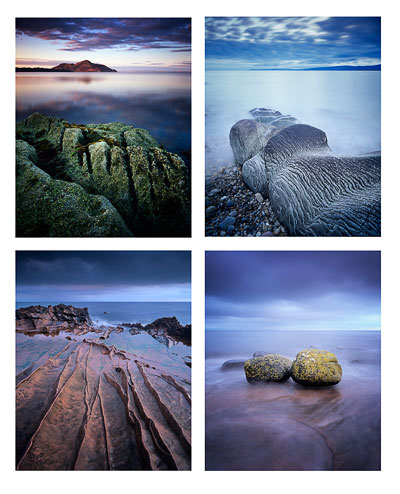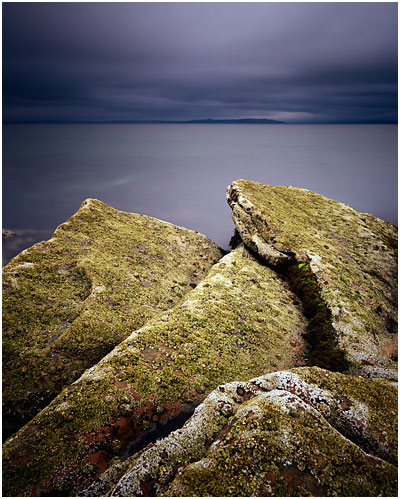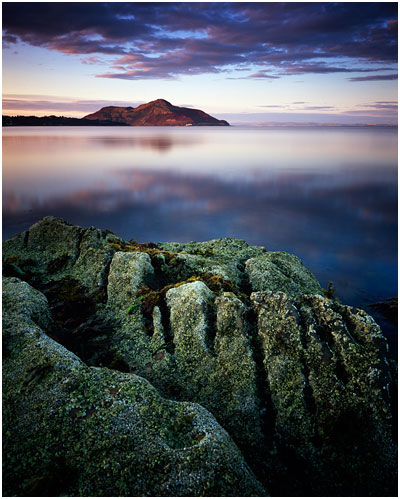I've been thinking about writing a post about my little Lumix Micro Four Thirds acquisition for some time, and I'm just back from the Isle of Arran where I used the camera as a teaching aid while running my workshop.
I should start off by declaring that I am no digital shooter. I have been shooting film 100% for the past 20 odd years and I don't intend to alter this in the foreseeable future. The argument is a tired one and I wish not to go there. However, I did see value in having a digital system for use on my workshops, because having one would allow me to illustrate compositional techniques and also show others what I'm seeing in the landscape.
I had a bit of a hard time choosing a digital system. I didn't want to break the bank and get something 'pro', and yet, me being me, I knew any digital system I bought would have to be good enough to do landscape images with. So many of the 'Compact' cameras were not in the running for me. And those that had good quality sensors, didn't feel like they had the lens selection that I would like to invest in.
The Micro Four Thirds format seemed to fit the bill for a few reasons. Firstly, the cost of a basic kit system with the equivalent of a 28-90 zoom lens is very inexpensive. Secondly the sensor size isn't that far away from APS quality. And to make the decision for me, the very small size of the outfit was ideal - I didn't want to lug around a second full-sized system if I am already carrying a medium format film system.
I initially bought the Lumix GF1 a few years ago, but I never really considered that it could potentially be a serious contender for digital landscape photography. It's only since I bought the Lee Seven5 filter system for my new GX1, that I've come to consider that this format is something I would choose, if I were a digital shooter. I think the selection of lenses, image quality, compactness of the format makes for a terrific way forward.
So I thought that I would post some images made from my workshop this week. They were all composed hand-held, with the Lee Seven5 series of hard-grads. There are a few things I would like to point out about the combination Lee filters and also the practicalities of using such a small format. Here they are:
1) I find in general, that the Seven5 hard-grads are too hard. I've always considered that hard-grads are more important than soft-grads, and this is because they become diffused when used with any focal length above 24mm. As you go up the focal lengths towards telephoto, the hard-grads become soft until they become non-effective. If you consider that you are 'zooming into the graduation' as you go up the focal lengths, and that the filter is before the focal plane, then it's not hard to see that hard-grads are in fact 'soft' when used on 35mm systems and upwards. For my medium format system where my wide angle lens is a 50mm, my hard-grad is very soft. I use a rangefinder system so although I can't see through the lens, filter placement has never been a major concern for me, because at focal lengths of 50mm and above, the grad is pretty soft any way. The only time I would notice the grad is when I'm using one that is too strong for the subject matter.
Let's consider what happens when we go down the focal-lengths. We are essentially 'zooming out' away from the grad, and so hard-grads become more obvious. With the Micro Four Thirds format, you are dealing with small focal lengths. A lens that gives you the same field of view as a 35mm camera is half the focal length. For instance, a 24mm lens on a 35mm system is replaced by a 12mm lens in the Micro Four Thirds format. Of course, you could argue that the small diameters of the Micro Four Thirds lenses should alleviate this, but in my experience - they don't.
In summary, I would say that the Lee Seven5 set of hard-grads are very useful on a Micro-Four-Thirds system, but sometimes you might want to use the soft grads a bit more than you normally would due to the lower focal lengths. So buy both the soft, as well as the hard grads for this system.
2) Focussing the micro-four thirds system to take advantage of the hyper-focal for Depth of Field is a pain. The lenses I have really don't like to be stopped down more than 5.6, maybe f8 at times, but even then I saw degradation in the image quality. f5.6 at 12mm is still a lot of depth of field, but I did find I often missed the mark when setting the hyper-focal. I found using the electronic viewfinder a must. It is a focussing aid that you should buy for this camera if you intend to try to keep the lenses from being stopped down more than required.
These two points aside, I would dearly love to know why there is no high-performance sensor - one that is equivalent to something like a D800 in the camera bodies of the Micro Four Thirds format. At low ISO, the sensors in these cameras are perfectly fine, but they get very noisy from ISO 800 upwards. It's not something I miss, as I'm used to working with 50 ISO with my Fuji Velvia film, but I can appreciate that for most digital shooters, having good image quality at high ISO's is something they take for granted these days. I would like to know why this kind of technology has not been put into the MFT format as yet - is it to do with size, price, or even energy requirements? Or is it because the manufacturers think this is a 'toy format'?
For me, I don't think MFT is a toy format. I think it may well be the future. I've enjoyed shooting the Lumix, and composing using the electronic view finder. I'm really pleased I bought it for use on my workshops. It's a great little system, and one that I would adopt full time, if I wasn't the avid film shooter than I am.





